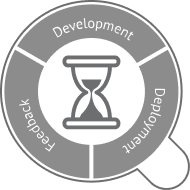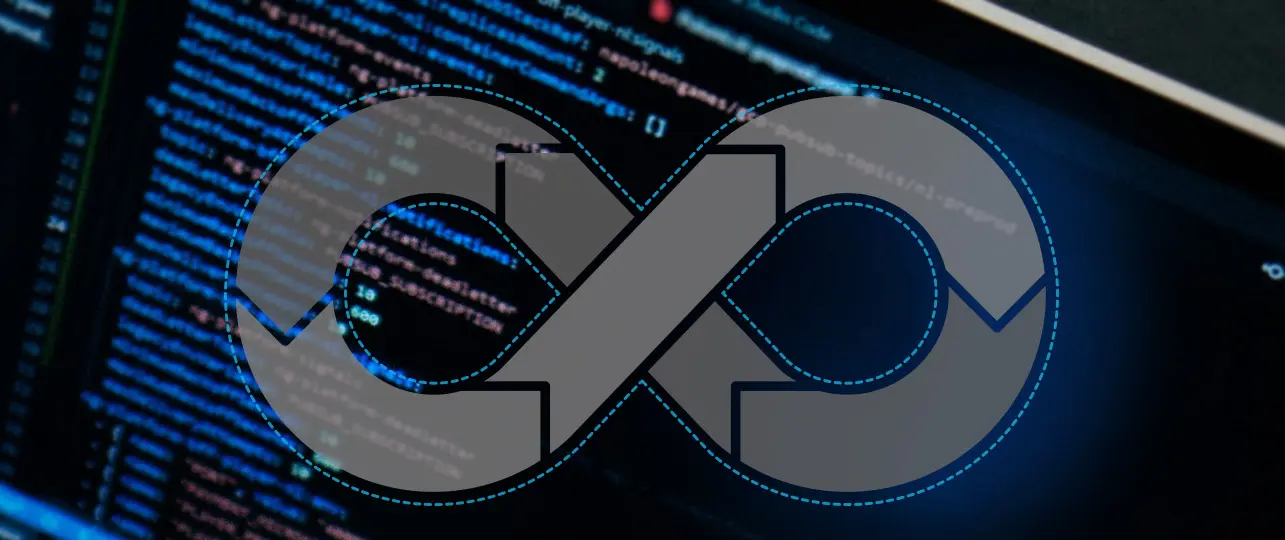CI/CD vs DevOps: Overview
In the realm of software development and deployment, two critical methodologies have emerged to revolutionize the way we create and deliver software: Continuous Integration and Continuous Delivery (CI/CD) and DevOps. While these two concepts share the overarching goal of enhancing the software development and delivery process, they do so through distinct approaches and have different scopes. To grasp the full picture, it’s vital to understand what CI/CD and DevOps represent and how they contribute to software development excellence. Below, we delve into a comprehensive overview of each:
CI/CD (Continuous Integration and Continuous Delivery):
CI/CD primarily centers on the automation of the software delivery pipeline. Its core purpose is to ensure that code integration, testing, and delivery to production are seamlessly and continuously executed.
Key Objectives:
Accelerated Releases: CI/CD strives to expedite the software release cycle by eliminating bottlenecks and automating manual processes.
Enhanced Reliability: By automating testing and deployment, CI/CD minimizes the risk of human error and fosters more reliable software releases.
In essence, CI/CD is like the streamlined engine of software development, geared toward delivering code with efficiency and precision.
DevOps:
DevOps represents a more holistic and cultural approach to software development. Its aim is to bridge the gap between traditionally siloed development and operations teams, fostering a culture of collaboration, automation, and perpetual enhancement.
Key Objectives:
Collaboration: DevOps emphasizes a seamless collaboration between development and operations teams, breaking down barriers that can hinder the software delivery process.
Automation: Automation is a cornerstone of DevOps, automating tasks, tests, and deployments to improve efficiency and consistency.
Continuous Improvement: DevOps encourages a culture of continuous learning and refinement, where teams regularly assess and enhance their processes.
What is CI/CD?
In the ever-evolving landscape of software development, CI/CD (Continuous Integration and Continuous Delivery) stands as a transformative set of practices and automation techniques. Its primary mission is to empower development teams to craft, test, and deploy software with unprecedented speed and reliability. In this article, we delve into the intricacies of CI/CD, dissecting its core components and elucidating its pivotal role in modern software development.
CI/CD is a set of software development practices and automation techniques that enable teams to build, test, and deliver software more rapidly and reliably.
CI
Continuous Integration
Developers regularly merge their code changes into a shared repository. Automated build and test processes are triggered with each integration to ensure code quality and detect issues early.
CD
Continuous Delivery
CD extends CI by automating the deployment pipeline. It ensures that code changes can be automatically and consistently delivered to various environments (e.g., testing, staging, production) with minimal manual intervention.
Benefits of CI/CD
The benefits of CI/CD (Continuous Integration and Continuous Delivery) include:
- ➤ Faster Software Delivery: CI/CD automates the build, test, and deployment processes, enabling faster and more frequent software releases.
- ➤ Higher Software Quality: Automated testing and continuous integration catch bugs and issues early, leading to higher code quality.
- ➤ Reduced Manual Work: CI/CD minimizes manual intervention, reducing errors and freeing up developers’ time for more valuable tasks.
- ➤ Consistency: CD ensures consistent and repeatable deployments across different environments, reducing deployment-related errors.
- ➤ Risk Mitigation: Early issue detection and rapid rollback capabilities reduce the risk associated with software releases.
- ➤ Improved Collaboration: CI/CD promotes collaboration between development and operations teams, fostering a culture of shared responsibility.
- ➤ Customer Satisfaction: Faster delivery of new features and bug fixes leads to improved customer satisfaction.
- ➤ Competitive Advantage: Rapid and reliable software releases allow organizations to respond quickly to market changes and stay competitive.
Examples of CI/CD Pipeline
- Web Application: A CI/CD pipeline for a web app involves automating the build, testing, and deployment process. After code changes are made, the pipeline automatically builds the application, runs unit tests, and then deploys it to a staging environment for further testing. If all tests pass, the changes are promoted to the production environment, ensuring a smooth and reliable release.
- Mobile App: In the realm of mobile app development, CI/CD pipelines automate the entire lifecycle. Code is built for both iOS and Android platforms, unit tests are executed, and the app is deployed to a testing environment. After successful testing, it’s further deployed to app stores like the Apple App Store and Google Play for end-users to access.
- Microservices Architecture: For microservices, CI/CD pipelines automate the building and packaging of individual microservices. Unit tests are run, and Docker containers are created. These containers are then deployed to a container orchestration platform, such as Kubernetes, ensuring scalability and efficient management of microservices.
- Database Changes: When making database schema changes, a CI/CD pipeline is essential for ensuring data consistency and reliability. The pipeline applies schema changes and runs migration scripts in a controlled and automated manner, eliminating manual errors in the process.
- Serverless Functions: In the serverless world, CI/CD pipelines handle serverless function deployment seamlessly. They package functions, run unit tests, and then deploy them to a serverless platform like AWS Lambda or Azure Functions, making it easy to scale and manage serverless applications.
What is DevOps?
DevOps represents a dynamic framework of practices that harmoniously melds the realms of software development (Dev) and operations (Ops) into a cohesive, automated, and streamlined process for software delivery. In this article, we unveil the transformative essence of DevOps, elucidating its core objectives that revolve around speed, quality, collaboration, and a ceaseless journey of improvement.
Benefits of DevOps
DevOps offers numerous advantages for software development and operations:
- ➤ Faster Software Delivery: Streamlines and automates processes for quicker and more frequent releases.
- ➤ Improved Software Quality: Automated testing and continuous integration enhance code quality.
- ➤ Enhanced Collaboration: Fosters teamwork and shared responsibility across teams.
- ➤ Increased Efficiency: Automation reduces manual tasks, optimizing resource allocation.
- ➤ Risk Reduction: Minimizes issues with automated testing, monitoring, and rollback capabilities.
- ➤ Greater Flexibility: Allows rapid responses to market changes and customer feedback.
- ➤ Cost Savings: Improves efficiency, reduces downtime, and enhances resource management.
- ➤ Enhanced Security: Addresses security and compliance early in development.
- ➤ Continuous Improvement: Promotes ongoing optimization of processes.
- ➤ Competitive Advantage: Enables quicker responses to market demands, giving an edge in the business world.
Understanding Cycle Time
Cycle time refers to the total time it takes to complete a process or a workflow from the beginning to the end.
Components of Cycle Time:
- Development time: Time spent on coding, testing, and building the software.
- Deployment time: Time taken to deploy the software to production.
- Feedback time: Time required to gather feedback and make improvements.

Importance of Measuring Cycle Time:
- Identifying bottlenecks and inefficiencies
- Evaluating process improvements
- Enhancing overall workflow efficiency
Shortening Your Cycle Time with DevOps
Incorporating DevOps principles into your software development process can significantly reduce cycle time, leading to faster and more reliable software delivery.
CI
Continuous Integration
- Automated Integration: Automate the process of integrating code changes from multiple developers.
- Frequent Testing: Run automated tests with every code commit to identity and resolve issues early.
- Benefits: Early detection of integration issues, smoother collaboration, and higher code quality.
CD
Continuous Delivery
- Automated Deployment: Automate the deployment process to various environments, from development to production.
- Release Confidence: Frequent and automated deployments ensure that the codebase is always in a deployable state.
- Benefits: Faster and more consistent releases, reduced risk of deployment errors.
Examples of DevOps
- Infrastructure as Code (IaC): DevOps teams employ IaC tools like Terraform and Ansible to automate the provisioning and configuration of infrastructure. This enables the rapid and consistent deployment of servers, networks, and resources, reducing manual errors and enhancing scalability.
- Continuous Integration/Continuous Deployment (CI/CD): CI/CD pipelines automate the build, testing, and deployment of software. This approach ensures that code changes are tested and delivered rapidly and reliably. Developers can commit code changes, and the pipeline handles the rest, promoting a culture of efficiency and collaboration.
- Microservices Architecture: Embracing microservices allows organizations to break down monolithic applications into smaller, manageable services. DevOps practices support the creation and orchestration of these microservices, enabling teams to independently develop, test, and deploy components. This enhances agility and accelerates the release of new features.
- Monitoring and Automation: DevOps emphasizes continuous monitoring and automated alerting. Tools like Prometheus and Grafana enable real-time visibility into application and infrastructure performance. When issues are detected, automation can take corrective actions, reducing downtime and enhancing system reliability.
- Collaboration and Communication: Effective collaboration and communication are at the core of DevOps. Teams work closely, breaking down silos between development and operations. This cultural shift fosters shared responsibility and encourages knowledge sharing, leading to smoother and more efficient development and deployment processes.
Key Differences Between CI/CD vs DevOps
Understanding the key differences between DevOps and CI/CD is essential for optimizing your software development processes.CI/CD (Continuous Integration/Continuous Deployment) and DevOps are closely related concepts but have distinct differences:
| CI/CD | DevOps | |
|---|---|---|
| Scope | Focuses on automating and streamlining the software delivery pipeline, from code integration (CI) to deployment (CD). | Encompasses a broader cultural and organizational approach to software development and IT operations, including collaboration and communication between teams. |
| Goal | Aims to automate and optimize the process of building, testing, and deploying code, enabling faster and more reliable releases. | Aims to bridge the gap between development and operations teams, fostering a culture of collaboration, automation, and continuous improvement. |
| Automation | Primarily focuses on automating the code integration, testing, and deployment stages. | Emphasizes automation across the entire software development lifecycle, including infrastructure provisioning and monitoring. |
| Culture | Largely a technical practice focused on tools and processes. | Emphasizes a cultural shift, encouraging collaboration, shared responsibilities, and communication among teams. |
| Ownership | Owned by development teams to streamline the release process. | Encompasses both development and operations teams, fostering shared ownership and responsibilities. |
| Continuous Integration vs. Continuous Deployment | Involves automatically integrating code changes into a shared repository and running tests to ensure code quality. | Encompasses both Continuous Delivery (automated deployment to a staging environment) and Continuous Deployment (automated deployment to production). |
When comparing DevOps vs CI/CD, it’s crucial to recognize that CI/CD is a subset of the broader DevOps philosophy, with a primary focus on automating the delivery pipeline, while DevOps is a holistic approach that emphasizes cultural and organizational changes to improve collaboration and efficiency in software development and operations.
CI/CD vs DevOps: Process
CI/CD (Continuous Integration/Continuous Delivery) and DevOps are related but distinct concepts in software development and deployment. Here’s a brief overview of their processes:
CI/CD (Continuous Integration/Continuous Delivery):
Continuous Integration (CI):
Developers frequently merge their code changes into a shared repository. Automated tests are run to ensure that new code integrates smoothly with existing code.
Continuous Delivery (CD):
After successful CI, the software is automatically built, tested, and deployed to a staging environment. It’s in a deployable state, ready for manual approval to be released to production.
Continuous Deployment:
If desired, CD can extend to automatic production deployment without manual intervention, provided all tests pass in the staging environment.
DevOps:
Culture:
DevOps emphasizes a culture of collaboration and communication between development and operations teams, breaking down silos.
Automation:
Automation plays a crucial role in DevOps, automating manual tasks, including infrastructure provisioning, configuration management, and deployment.
Monitoring and Feedback:
Continuous monitoring of applications and infrastructure helps identify issues and gather feedback for further improvements.
Feedback Loop:
DevOps encourages a feedback loop for continuous improvement, with teams regularly reviewing and refining their processes and tools.
CI/CD vs DevOps: Implementation
CI/CD vs DevOps, while related, have different scopes in implementation:
| CI/CD (Continuous Integration/Continuous Delivery) | DevOps | |
|---|---|---|
| Implementation Focus | Primarily focuses on automating the code integration, testing, and deployment process. | Encompasses a broader range of practices and cultural changes, including collaboration between development and operations teams. |
| Tools and Practices | Involves tools like Jenkins, Travis CI, GitLab CI/CD, and practices such as automated testing, version control, and deployment pipelines. | Includes tools like Docker, Kubernetes, Ansible, and emphasizes practices like infrastructure as code (IaC), continuous monitoring, and cross-functional team collaboration. |
| Goal | To enable frequent code integration, automated testing, and reliable, automated software delivery. | To create a culture of collaboration, automation, and continuous improvement throughout the entire software development and IT operations lifecycle. |
Azure Pipelines
Azure Pipelines is a reliable continuous integration and delivery service. Jobs can be grouped into stages, providing automation for building, testing, and release. The process has evolved from separate Build and Release pipelines to a unified .yaml-based approach.
“Pipeline as code” is a concept related to defining and managing your CI/CD pipelines using code or configuration files rather than manually configuring them through a graphical user interface. In the context of Azure Pipelines, this is achieved using a technology called Azure DevOps YAML pipelines. Here’s how they relate:
- Azure Pipelines: This is the service that allows you to create, manage, and execute CI/CD pipelines. You can use Azure Pipelines to manually create and configure your build and deployment workflows through a web-based UI.
- Pipeline as Code: With Pipeline as Code, you define your CI/CD pipelines using code, typically in a YAML file. This code specifies the steps, triggers, and conditions for your build and deployment processes. Azure Pipelines supports this through YAML-based configuration files.
What is CI/CD in DevOps?
CI/CD (Continuous Integration/Continuous Delivery) in DevOps refers to the automated processes and practices that enable seamless integration of code changes, automated testing, and continuous delivery of software updates. It’s a critical component of DevOps, ensuring that code changes are built, tested, and deployed rapidly and reliably, contributing to faster and more efficient software development and deployment.
Summary
In essence, DevOps serves as the overarching framework that encompasses CI/CD and a wider spectrum of practices and principles, creating an environment where teams work harmoniously to achieve the ultimate goal of delivering high-quality software swiftly. In modern software development, DevOps and CI/CD complement each other, enhancing speed, quality, and collaboration within the software development lifecycle.
In conclusion, while CI/CD vs DevOps both strive to enhance software development and delivery, they do so from different angles. CI/CD is the engine that automates the software delivery pipeline, ensuring rapid and reliable releases, while DevOps represents a cultural shift that promotes collaboration, automation, and continuous improvement, transforming the entire software development ecosystem. Together, these methodologies drive innovation and excellence in the dynamic world of software development.
Integrating CI/CD and DevOps practices can lead to efficient software development, promoting automation and collaboration across teams.
DevCom as a DevOps services provider, offers complete DevOps solutions for businesses, which encompass all aspects of the development and operations cycle. From continuous integration and delivery to cloud infrastructure management, we have the expertise and tools to help you succeed.
Get started today and transform your development process into a seamless, efficient, and agile operation.
FAQ
Testing and Automation in CI/CD vs DevOps?
In CI/CD and DevOps:
- Testing: Involves automated unit, integration, and acceptance tests to ensure code quality.
- Automation: Applies to testing, infrastructure provisioning, monitoring, security scanning, and feedback loops.
What are the two critical components of DevOps?
Two critical components of DevOps are:
- Culture: DevOps emphasizes collaboration, communication, and a culture of shared responsibility between development and operations teams.
- Automation: Automation of processes, from code integration and testing to deployment and infrastructure provisioning, is fundamental for streamlining software delivery in DevOps.
How to Implement CI/CD within a DevOps Culture?
To implement CI/CD within a DevOps culture:
- Foster a DevOps culture of collaboration.
- Use version control (e.g., Git).
- Automate builds, tests, and deployments.
- Integrate automated testing.
- Implement continuous monitoring.
- Emphasize security and compliance.
- Collect and act on feedback.
- Document processes and train teams.
- Encourage scalability and flexibility.
- Promote continuous learning and improvement.
What are agents and agent pools?
When your pipeline is in operation, the system initiates one or more jobs. An agent refers to a computational framework equipped with agent software, which executes a single job sequentially.
You can choose Microsoft agents.
- Maintenance & upgrades are taken care by Microsoft.
- On each run, it’s a new VM/container & discarded after one use.
You can also build your own agent as a self-hosted agent.
- You control the VM & container
- Can run in Azure or On-Premise
- You need to create a Personal Access Token with Agent Pool scope to configure your agent.
- Good way to integrate on-prem & cloud systems
Organize agents into agent pools for easier management.
Pools are scoped to & visible in the entire organization.
Default agent pools
- Default pool: Use it to register self-hosted agents that you’ve set up.
- Azure Pipelines hosted pool with various Windows, Linux, and macOS images.
Examples of Azure-hosted pools:
- Ubuntu 22.04: Run jobs on a Linux-based VM
- macOS latest: Build & release on Monterey macOS
- Windows:
Windows 2022 with VS2022
Windows 2019 with VS2019









